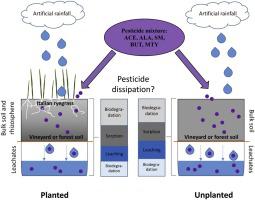当前位置:
X-MOL 学术
›
Agric. Ecosyst. Environ.
›
论文详情
Our official English website, www.x-mol.net, welcomes your
feedback! (Note: you will need to create a separate account there.)
Plants affect the dissipation and leaching of anilide pesticides in soil mesocosms: Insights from compound-specific isotope analysis (CSIA)
Agriculture, Ecosystems & Environment ( IF 6.0 ) Pub Date : 2021-03-01 , DOI: 10.1016/j.agee.2020.107257 Paula Pérez-Rodríguez , Anne-Desirée Schmitt , Sophie Gangloff , Jérémy Masbou , Gwenaël Imfeld
Agriculture, Ecosystems & Environment ( IF 6.0 ) Pub Date : 2021-03-01 , DOI: 10.1016/j.agee.2020.107257 Paula Pérez-Rodríguez , Anne-Desirée Schmitt , Sophie Gangloff , Jérémy Masbou , Gwenaël Imfeld

|
Abstract The soil-plant system can act as a prevailing zone of pesticide dissipation in agroecosystems, which may influence pesticide leaching following rainfall events. Here we examined the contribution of leaching, dissipation and degradation of widely used anilide pesticides in planted and unplanted mesocosms with contrasting vineyard and forest soils. The mesocosms were spiked at 25 mg/kg with acetochlor, alachlor, S-metolachlor, butachlor and metalaxyl, and followed-up for 75 days. Successive rainfalls were applied on days 45, 60 and 75 to collect pesticide leachates. Bulk soil and rhizosphere samples were collected to evaluate pesticide dissipation. Up to 14 % of initially spiked pesticides was exported by leaching. The first rainfall accounted for 69–99% of the total pesticide leaching. Pesticide dissipation in soil mesocosms on day 75 ranged from 58 to 99 % and was larger in planted than in unplanted mesocosms. Compound-specific stable isotope analysis (CSIA) of the pesticides showed that biodegradation in both the vineyard and forest soil mesocosms occurred mainly in the soil solution that was leached following rainfall events rather than in the bulk soil. Changes in carbon isotope values (Δδ13C up to 13.9 ± 0.5‰) of acetochlor, alachlor, S-metolachlor and butachlor in leachates were more pronounced in planted than in unplanted mesocosms, indicating predominant pesticide degradation in the planted mesocosms. Pesticide biodegradation was favoured in the soil solution of soil-plant systems, independently of the soil type. Leaching of the soil solution, pesticide ageing and biodegradation in the bulk soil and the rhizosphere were the main processes of pesticide dissipation. Overall, this study emphasizes the variability of leaching and degradation of anilide pesticides in agricultural soils, and proposes a framework using CSIA to examine the contribution of dissipation processes in soil-plant systems.
中文翻译:

植物影响土壤中层环境中苯胺类农药的消散和浸出:化合物特异性同位素分析 (CSIA) 的见解
摘要 土壤-植物系统可以作为农业生态系统中农药消散的主要区域,可能会影响降雨事件后农药的浸出。在这里,我们研究了广泛使用的苯胺杀虫剂在种植和未种植的中层空间中浸出、消散和降解的贡献,以及对比葡萄园和森林土壤。以 25 mg/kg 的浓度向中间空间添加乙草胺、甲草胺、S-异丙甲草胺、丁草胺和甲霜灵,并跟踪 75 天。在第 45、60 和 75 天连续降雨以收集农药渗滤液。收集大量土壤和根际样品以评估杀虫剂的消散。多达 14% 的最初加标农药是通过浸出出口的。第一次降雨占农药浸出总量的 69-99%。第 75 天土壤中层环境中农药的消散范围为 58% 至 99%,种植的中层环境比未种植的中层环境中的农药消散量更大。农药的化合物特异性稳定同位素分析 (CSIA) 表明,葡萄园和森林土壤中层空间的生物降解主要发生在降雨事件后浸出的土壤溶液中,而不是在大块土壤中。渗滤液中乙草胺、甲草胺、S-异丙甲草胺和丁草胺的碳同位素值变化(Δδ13C 高达 13.9 ± 0.5‰)在种植中比在未种植中更显着,表明在种植中中环境中农药降解占主导地位。农药生物降解在土壤-植物系统的土壤溶液中受到青睐,与土壤类型无关。浸出土壤溶液,农药在大块土壤和根际的老化和生物降解是农药消散的主要过程。总体而言,本研究强调了农业土壤中苯胺类农药浸出和降解的可变性,并提出了一个使用 CSIA 来检查耗散过程在土壤-植物系统中的贡献的框架。
更新日期:2021-03-01
中文翻译:

植物影响土壤中层环境中苯胺类农药的消散和浸出:化合物特异性同位素分析 (CSIA) 的见解
摘要 土壤-植物系统可以作为农业生态系统中农药消散的主要区域,可能会影响降雨事件后农药的浸出。在这里,我们研究了广泛使用的苯胺杀虫剂在种植和未种植的中层空间中浸出、消散和降解的贡献,以及对比葡萄园和森林土壤。以 25 mg/kg 的浓度向中间空间添加乙草胺、甲草胺、S-异丙甲草胺、丁草胺和甲霜灵,并跟踪 75 天。在第 45、60 和 75 天连续降雨以收集农药渗滤液。收集大量土壤和根际样品以评估杀虫剂的消散。多达 14% 的最初加标农药是通过浸出出口的。第一次降雨占农药浸出总量的 69-99%。第 75 天土壤中层环境中农药的消散范围为 58% 至 99%,种植的中层环境比未种植的中层环境中的农药消散量更大。农药的化合物特异性稳定同位素分析 (CSIA) 表明,葡萄园和森林土壤中层空间的生物降解主要发生在降雨事件后浸出的土壤溶液中,而不是在大块土壤中。渗滤液中乙草胺、甲草胺、S-异丙甲草胺和丁草胺的碳同位素值变化(Δδ13C 高达 13.9 ± 0.5‰)在种植中比在未种植中更显着,表明在种植中中环境中农药降解占主导地位。农药生物降解在土壤-植物系统的土壤溶液中受到青睐,与土壤类型无关。浸出土壤溶液,农药在大块土壤和根际的老化和生物降解是农药消散的主要过程。总体而言,本研究强调了农业土壤中苯胺类农药浸出和降解的可变性,并提出了一个使用 CSIA 来检查耗散过程在土壤-植物系统中的贡献的框架。










































 京公网安备 11010802027423号
京公网安备 11010802027423号